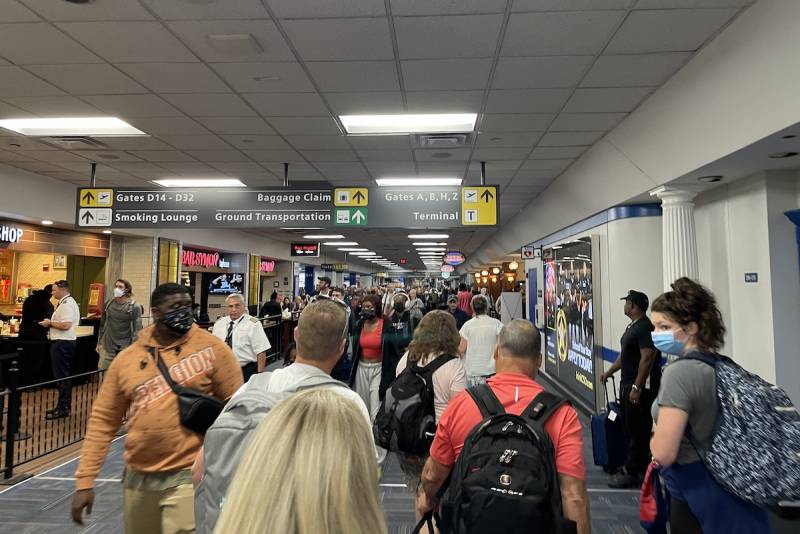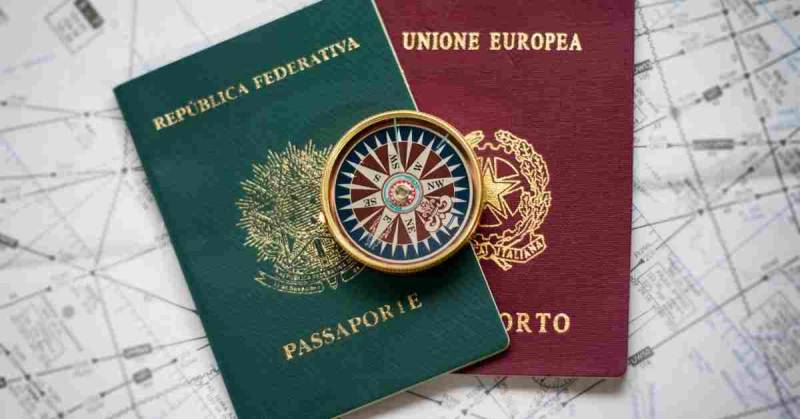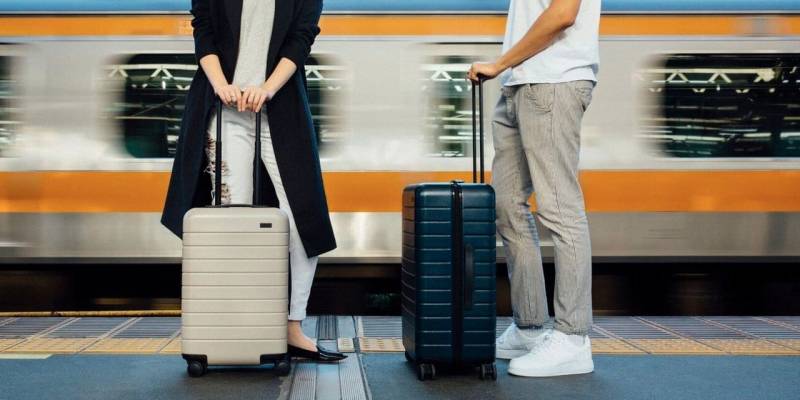Airports are busy and planes are crowded as the airline industry nears pre-pandemic travel numbers. In the U.S. over the weekend of June 24, security screening numbers were the highest since February 2020 and down just 8 percent compared to the same weekend in 2019.
But the return of travelers is proving more difficult for the industry than many thought it would be.
Thousands of flights have been preemptively removed from airline schedules this summer in the face of staffing and other issues. In the U.S., trade group Airlines for America (A4A) estimates that 15 percent of planned summer flights have already been cut from June through August. And the flights that do operate face a long list of potential issues, from crew availability to air traffic control and airport staffing, and weather.
In Europe, images of thousands of stranded bags at London’s Heathrow airport, and security queues snaking out of the terminal at Amsterdam’s Schiphol airport have grabbed headlines. From June 1-23, roughly 2 percent of all flights in Europe were cancelled, according to Cirium data. That’s not a wholly bad number but not great for an industry that strives to complete more than 99 percent of its flights.
How We Got Here
One must rewind to the early days of pandemic in 2020. Airlines faced a historic collapse in travel demand with, for example in the U.S., traveler numbers hitting levels unseen since the 1950s. The industry had to shrink, and fast.
To survive, airlines offered early retirement, voluntary departure, and unpaid leave packages to staff to reduce their payrolls. U.S. carriers were barred from involuntarily furloughing employees under the federal CARES Act relief measure that was signed into law in March 2020. Elsewhere, they were not as lucky with many furloughing or laying off staff, filing for bankruptcy, or even closing their doors for good.
U.S. airlines shed more than 84,000 employees from February to October 2020 when employment bottomed out at 669,172 people, according to Bureau of Transportation Statistics (BTS) data.
Now, those staffing reductions are coming back to bite the industry. This first began to emerge last summer in the U.S. when, for example, American Airlines had to cut schedules due to a pilot training backlog, and other airlines asked management staff to help out at airports. But instead of getting better the situation got worse: the economy heated up, entry-level workers found themselves in high demand, and the entire aviation industry, from airlines to airports and the U.S. Transportation Security Administration (TSA), found themselves competing with the Amazon’s of the world for workers.
“The industry … asked some employees to take voluntary leaves during the worst of the pandemic and many of those people have found other careers, so they aren’t coming back,” Cowen & Co. analyst Helane Becker wrote on June 17.
Where Are the Problems?
Different aspects of the same problem — staffing — plague different parts of the world. In Europe, most airlines point to airports and air traffic control organizations for the issues they face there. British Airways CEO Sean Doyle called out the operator of Heathrow in May for failing to staff the airport based on airline schedules. And Lufthansa puts the blame for its flight cancellations on air traffic control “strikes, weather events and, in particular, an increased Corona sickness rate” among both airline and airport staff.
Amsterdam Schiphol, Hamburg, and Brussels airports saw the most cancellations among European airports from June 1-23, Cirium data show.
“The issues are endemic throughout the aviation ecosystem,” said Virginia Lee, a spokesperson for the European airports trade group the Airports Council International (ACI) Europe. She noted that it can take up to six months to hire and credential a new employee at some European airports, a timeline that makes it difficult to quickly rectify any staffing shortfall.
European airlines also face the added stress of industrial action. Brussels Airport was closed June 24 due to a national strike. Brussels Airlines and Ryanair have both faced strikes already in June. And two British Airways unions whose members include check-in staff at Heathrow are threatening to go on strike later this summer.
The situation in the U.S. appears to fall more on airlines themselves. A well-documented shortage of pilots is hitting regional carriers hard and forcing them to cancel flights to small cities; mid-tier airlines like Alaska Airlines and JetBlue Airways face elevated pilot attrition that is limiting their schedules; and American Airlines and Delta Air Lines have both acknowledged a backlog training new pilots.
Air traffic control staffing is also proving a factor in the U.S. A center in Jacksonville that oversees most flights into and out of Florida has had repeated shortages that have limited flights through its airspace in recent months.
And, on both sides of the Atlantic, rising Covid infection rates means more staff out on quarantine, adding another wrinkle to airlines’ operational distress.
How Are Airlines Adjusting?
Cutting flights. The time to hire for summer travel is already past for most airlines and airports. As such, the industry has found that it must fly within its means — even if those means are not as grand as they hoped.
While many airlines cut their schedules ahead of the summer, more reductions continue to come as the problems prove worse than many initially thought. On June 23, United Airlines unveiled that it would cut 50 daily flights at Newark Liberty airport from July 1 through the end of the summer to reduce delays. Lufthansa and its budget subsidiary Eurowings, on the same day, more than tripled the number of flights they were cancelling in July and August to more than 3,100 from around 1,000. And Qantas Airways, on June 24, said it would trim its domestic Australia schedules by a further 5 points, to down 15 percent from plan, in July and August due to its own staffing issues, as well as high fuel prices.
In Europe, Amsterdam’s Schiphol and London’s Gatwick and Heathrow airports have all implemented caps on the number of flights to avoid overcrowding. These caps have prompted further schedule reductions at airlines. EasyJet, which has large operations at both Gatwick and Schiphol, has cut its system capacity by three points in the June quarter, and 10 points in the September quarter as a result.
The pilot shortage is proving a more intractable problem for U.S. airlines. Some small cities have already lost all air service, including Williamsport, Pa., last year. The industry has come together to boost the supply of pilots but, given the long training lead time, some are finding innovative ways to increase the supply, for example starting an entirely new airline.
What This Means for Travelers
The most direct impact on travelers are high fares. Data from Hopper show average U.S. domestic airfares of $385 in June. While that is down from a peak in May, the June number represents a 34 percent jump compared to last year and a 20 percent increase from 2019.
High fares do not appear to have dampened summer travel plans. Pent-up demand has proven stronger than the deterrent of high prices for most travelers. However, complaints have skyrocketed with the 5,079 filed with the U.S. Department of Transportation in April — the latest available month — a 322 percent increase over 2019 levels. The majority of these are regarding denied refund requests, according to the regulator.
High demand, and reduced schedules, also mean that when things do awry, travelers have few options for re-accommodation. It is increasingly common that, when a flight is cancelled, it may take airlines days to get all of those passengers on another flight. That comes at added cost to both airlines and travelers.
When Will Operations Improve?
“I think we’ll still have a challenging summer across the industry,” Frontier Airlines CEO Barry Biffle said on CNBC Monday. “The fall, I think, it gets much better.”
The fall is when the summer travel surge historically eases and airlines pullback schedules to cater to lower levels of demand, and giving themselves a much needed breather after the peak season. U.S. airlines operated 8 percent fewer domestic flights in September compared to August 2019, and 6 percent fewer over the same period in 2021, Cirium data show. These reductions give airlines more cushion to recover from staffing, weather, or other operational issues when they occur.
Of course, no one expects the pilot situation affecting U.S. airlines to ease once the summer is over. American has already said it will exit four small cities — Dubuque, Iowa, Islip and Ithaca, N.Y., and Toledo, Ohio — on September 7 due to a shortfall at its regional affiliates. Many expect the shortage to limit regional airlines, and maybe larger airlines like JetBlue, well into 2023 if not longer.
But, at the very least, travelers can expect more schedule reliability and fewer cancelled flights once they pack up their summer whites after Labor Day in September.
Edward Russell, Skift




